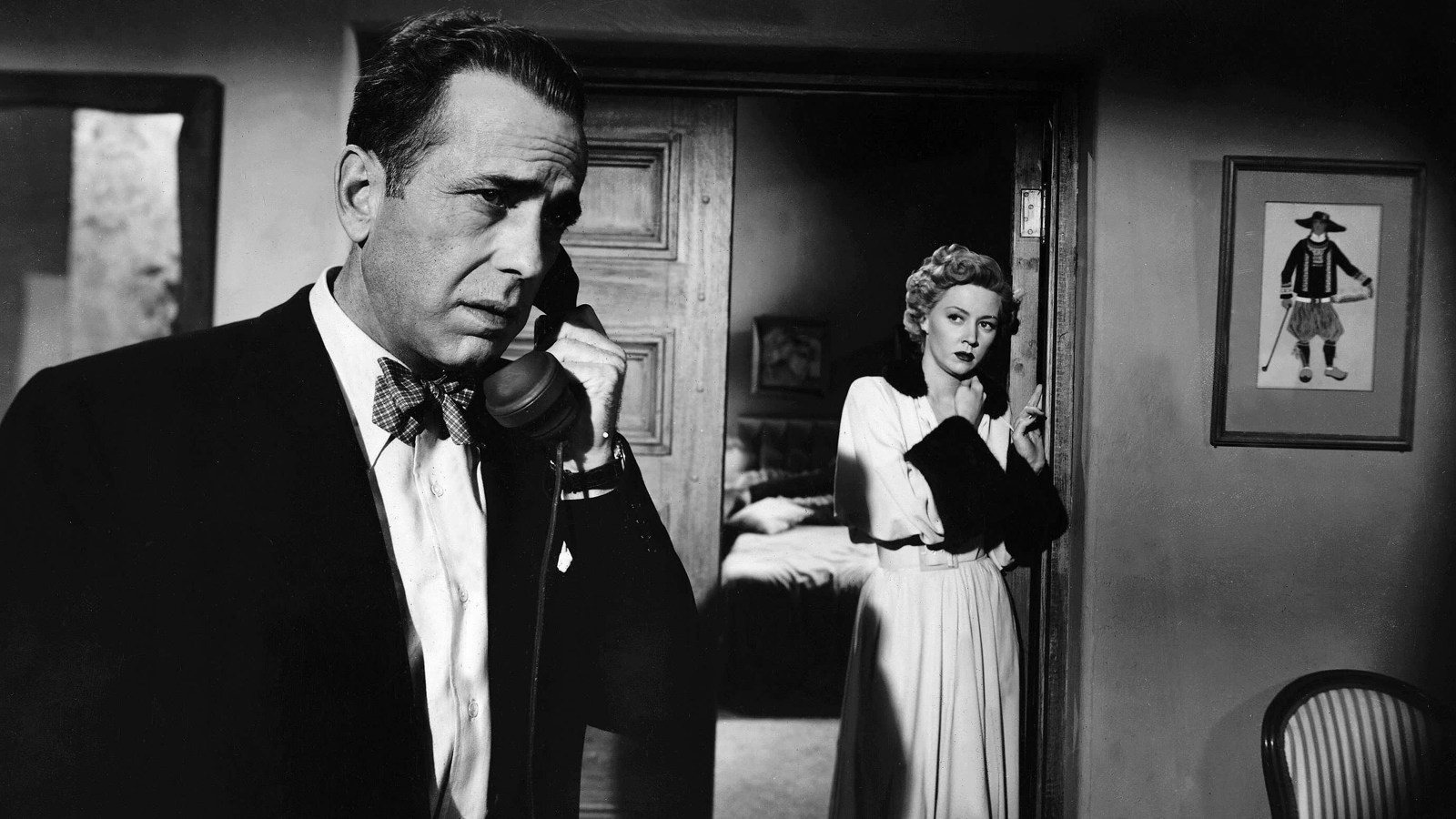Moral ambiguity, suspicion, smoldering femme fatales,
and the ever present threat of menace are just a few of the features that have
become synonymous with film noir. The 1950 noir classic In a Lonely Place twists these familiar elements to create a unique
entry in the genre that remains startlingly fresh nearly seventy years after
its release. Equal parts 50’s kitchen sink drama and 40’s whodunit, the film
takes noir off of the mean city streets and into the supposed comfort of the
home as it explores the ways in which a murder upends a couple’s life. Easily
one of the most haunting entries in the noir genre, In a Lonely Place turns genre and social conventions inside out in
a way that will leave viewers questioning the darkness lurking within us all.
 |
| Love means never calling the homicide unit |
The story begins with former hit screenwriter Dixon
Steele (Humphrey Bogart) descending into alcoholism and depression as he
struggles to revive his fading career. He reluctantly accepts an assignment to
adapt a trashy bestseller, but refuses to read the book, opting instead to hire
the hat-check girl at the local watering hole to summarize the plot for him.
The girl, Mildred Atkinson (Martha Stewart), happily obliges and accompanies
Dixon to his apartment, but is promptly sent on her way the moment that her
summary is complete. When the police discover Mildred strangled to death on the
side of the road the next morning, Dixon becomes the prime suspect in her
murder. Fortunately for him, however, his sultry neighbor, Laurel Gray (Gloria
Grahame) saw Mildred leave his apartment and provides him with an alibi. After
meeting at the police station Dixon and Laurel strike up an acquaintance that
quickly surpasses neighborly as she becomes his muse and consuming obsession.
Even as the couple grow closer, however, Mildred’s unsolved murder remains an
unspoken but palpable barrier between them. When continued pressure from the
police causes Dixon’s notorious temper to resurface Laurel begins to question
if the man she loves could be capable of murder.
In
a Lonely Place stands out from its fellow noirs by
subverting the conventions of its genre and era to reveal the dark side of
post-war America. The film takes viewers on a twisted journey from almost its
first frame as Humphrey Bogart appears on the screen in what appears to be
another of his signature world-weary hero roles. As the film continues,
however, it becomes apparent that the trademark Bogart cynicism is actually an
indication of something far more disturbing, as Dixon careens through an
evening marked by drunkenness, belligerent arguments, and bar fights. When
Mildred Atkinson’s body is found just minutes into the film, audiences are
already questioning if he might be the villain after all. As his character
falls under the spell of Gloria Grahame’s captivating Laurel, however, Bogart’s
familiar charm resurfaces, leading viewers to further question Dixon’s actions
and motives. Through its warped portrayal of the persona that made Bogart a
lasting cinematic icon the film calls into question not just viewers
expectations, but also the cynicism and vigilantism consistently promoted in
noir as a whole. Similarly, the film calls gender roles and sexual double
standards of its era into question through its sympathetic portrayal of Laurel
in spite of her checkered past. As the film progresses, Laurel evolves from the
brassy moll role that Grahame was so often typecast as to something far more
substantial; a complex and tormented woman. As the story’s focus shifts from
Mildred’s murder to its effect upon Dixon and Laurel, the film toys with
viewers yet again as the central question becomes not who committed the murder,
but how vast a shadow can one crime cast over a community. By the time that the
film reaches its emotionally shattering conclusion the notoriously warped film
noir genre will look more distorted than it ever has before or since.
 |
| Does this mean I might not get the girl in the end? |
Even with its superb script, the film easily could
have become just another b-thriller if not for the brilliant work of its cast.
Frank Lovejoy’s sympathetic portrayal of Dixon’s friend sergeant Nicolai
highlights his character’s inner conflict. Ruth Gillette lends the film much
needed comic relief in her role as the couple’s sassy housekeeper, Martha. Art
Smith imbues his performance as Dixon’s agent and confidante with an essential
warmth and good humor. Martha Stewart approaches her brief role as Mildred with
an infectious enthusiasm which ensures that her character resonates as more
than a mere plot device. Even while surrounded by apt supporting performances,
Bogart and Grahame own every frame in which they appear. Bogart captures the
nihilism beneath the surface of Dixon’s charisma in a brilliant inversion of
the cynical brand of cool that he made famous. Grahame is every bit his match
as she portrays Laurel’s outward confidence and inner vulnerability with equal
skill. Together, the pair expertly bring their characters to life in a way that
makes each fracture in their damaged souls achingly real.
In
a Lonely Place captures the isolation and
disillusionment concealed beneath the surface of post-war America with a poignancy
that sets it apart from other noir films of its era. Through the combination of
its intelligent script and raw performances the film more than earns its status
as a classic. For a visit to the not so good old days, join Humphrey Bogart and
Gloria Graham for a haunting journey In a
Lonely Place.


No comments:
Post a Comment